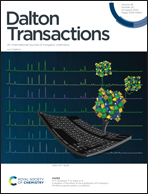The effect of isomerism and other structural variations on the G-quadruplex DNA-binding properties of some nickel Schiff base complexes†
Abstract
A series of novel isomeric nickel Schiff base complexes, as well as nickel complexes of related ligands having asymmetric structures have been prepared and characterised using microanalysis, 1H and 13C NMR spectroscopy and ESI-MS. The Schiff base ligands were prepared by condensation reactions involving ethylenediamine and different derivatives of benzophenone. The solid-state structures of eight of the complexes were also determined and revealed that each possessed a regular square planar coordination geometry around the metal ion. Many of the new complexes featured at least one, and in many instances two, protonatable pendant groups that enhance aqueous solubility. This enabled the DNA binding properties of the latter complexes to be explored using a variety of instrumental approaches, including ESI-MS, circular dichroism (CD) spectroscopy, FRET melting assays and FID assays, as well as molecular docking studies. The results of experiments performed using ESI-MS suggested that none of the nickel complexes exhibit a high affinity towards either a double stranded DNA (dsDNA) molecule D2, or the parallel unimolecular quadruplex DNA (qDNA) molecule Q1. In contrast, complexes (8) and (12) both gave spectra which reflected a significant level of binding to the parallel tetramolecular qDNA Q4. The results of binding experiments performed using CD spectroscopy suggested that (12) exhibits a significant level of affinity towards most types of DNA, while (4) shows a preference for interacting with parallel, unimolecular qDNA molecules. Complex (4) produced the lowest values of DC50 in FID assays performed using parallel Q1 or Q4, confirming its affinity for these qDNA molecules. The results of FRET melting experiments provided further evidence that (12), along with (8), can interact extensively with anti-parallel unimolecular qDNA. Experiments which monitored the effect of the nickel complexes on the melting temperature of D2 showed that none had a stabilising effect on this dsDNA molecule.



 Please wait while we load your content...
Please wait while we load your content...